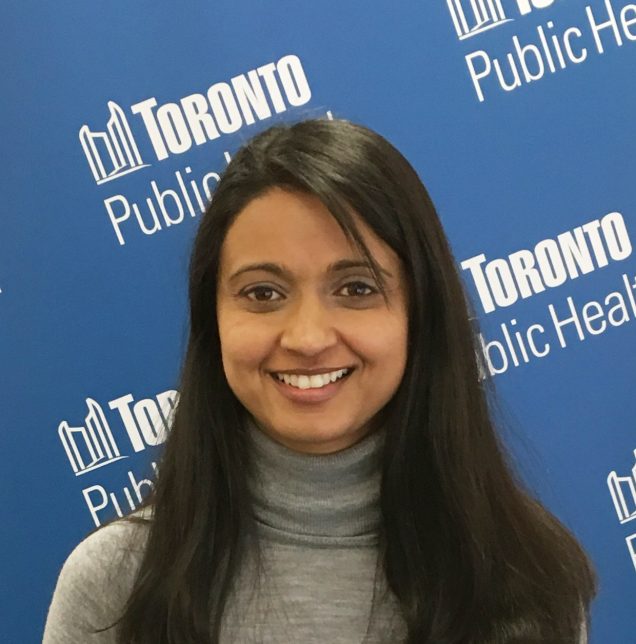Dr. Vinita Dubey, Toronto Public Health spokesperson: Aiming to reduce high infection rates in racialized and low-income areas
Dr. Vinita Dubey, Toronto Public Health spokesperson: Aiming to reduce high infection rates in racialized and low-income areas

Toronto Public Health (TPH) spokesperson Dr. Vinita Dubey, Associate Medical Officer of Health.
Credit: Toronto Public Health
“People may mistakenly believe that there’s an elevated risk of infection by going to certain parts of the city. This in turn contributes to misinformation and unintended stigma” – Dr. Vinita Dubey
By Irish Mae Silvestre
The Philippine Reporter
Why are minorities more susceptible to COVID-19?
In an interview with The Philippine Reporter, Toronto Public Health (TPH) spokesperson Dr. Vinita Dubey, Associate Medical Officer of Health, discussed the socioeconomic factors that contribute to high infection rates, as well as government efforts to help reduce the spread.
Understanding the effects of COVID-19 in minority communities
“TPH published its area-based findings on local COVID-19 cases at the end of May. While people may not have necessarily picked up the infection where they lived, having the case count and infection rate broken down per neighbourhood allows for health and community organizations to tailor services that meet the needs of specific communities.
“For example, this could include recommending pop-up testing clinics to be set up in a neighbourhood with a higher case rate. These area-based findings also brought to our attention how more systemic issues such as poverty and low income, vulnerable, precarious employment, housing and lack of access to services such as testing, may have increased the risk among residents living in areas of Toronto with high proportions of low-income earners and recent immigrants.”
On why minorities are disproportionately affected
“As such, TPH added voluntary socio-demographic questions to the case follow-up process to better understand and strengthen capacity to address whether or not COVID-19 may be disproportionately affecting certain people in our city.
“The first release of individual level data findings captured information from May 20 to July 16, 2020 and showed that people from certain racialized groups and people from low-income households were over-represented among reported COVID-19 infections. These are some examples of social determinants of health that have led to certain populations being more vulnerable to COVID-19.”
Ongoing government efforts
“One of TPH’s primary public health aims is to reduce health inequities and improve the health of the whole population. TPH is actively working with other city divisions and partner organizations to reduce inequities in how COVID-19 infection is affecting the population. This work includes:
• Consulting and collaborating with community agencies that serve groups of people who are over-represented in COVID-19 infection rates
• Focused health promotion messaging
• Recommending areas for focused testing
• Increasing opportunities for isolation for those unable to safely do so at home
• Continuing to bring attention to the social determinants of health and how all levels of government can address them
• Longer-term planning and advocacy for a more equitable system of health and social services.”
Contributing factors
“The mapped case information and other data indicate that a disproportionate number of COVID-19 cases have occurred among people who identified with a racialized group and in lower-income households and neighbourhoods. The reasons for this are unclear but could include existing health disparities linked to social and economic factors, stress caused by racism and other forms of discrimination, and challenges in participating in the public health response to COVID-19 including:
• difficulties in limiting COVID-19 exposure because of being an essential worker, and
• difficulties in physical distancing because of overcrowding; or
• inequitable access to health care and social services
“It’s difficult to pinpoint exactly what’s happening locally to influence the current case numbers in any given area. But there are a few factors which are relevant, including increased testing, transmission within households and, as already noted, the social determinants of health. For increased testing as an influencing factor, we know that the provincial testing strategy changed over the summer so that anyone who wanted to get testing could get it. Increased testing has increased the number of COVID-19 cases being confirmed, especially for asymptomatic individuals in certain areas such as the northwest Toronto neighbourhoods.
“Where a person lives does not necessarily indicate where they picked up COVID-19. It’s important to note that all areas of the city have been impacted by COVID. Areas with lower rates of COVID-19 cases are not inherently safer from a COVID-19 perspective. Additionally, looking at a map of cases, people may mistakenly believe that there’s an elevated risk of infection by going to certain parts of the city. This in turn contributes to misinformation and unintended stigma.
“Everyone’s at risk of getting COVID-19 anywhere when you’re in close contact with the respiratory droplets of someone who’s infected with the virus. We all have a shared responsibility to not create unnecessary social, physical or other harms in our community.
“This is why we continue to encourage people to follow the three steps of self-protection to reduce the spread of the virus in all public settings: watch your distance, wear your mask and wash your hands. Avoid contact with those outside your household and consider only leaving your house for essential activities such as work, grocery shopping, education and physical activity.”
Comments (0)